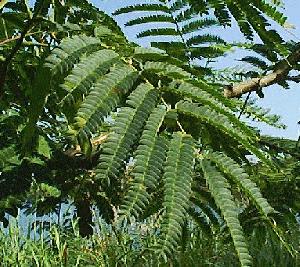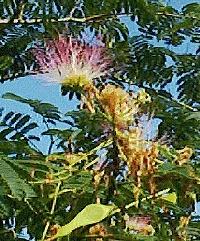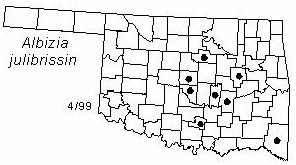

Small tree to 9 m (30 ft) tall and 20 cm (8 in) in diameter, usually with a short trunk and a broad flattened open crown. Bark gray to blackish, usually smooth. Twigs thick, glabrous, greenish brown. Buds small, round, no terminal bud. Leaves alternate, bipinnately compound, 15-35 cm (6-15 in) long, with 5-12 pairs of secondary axes. Leaflets 15-30 pairs, oblong, 10-15 mm (0.4-0.6 in) long, unequal-sided, short-pointed, dull green. Flowers numerous, in long-stalked spherical clusters in groups at ends of twigs, the many long threadlike pink stamens giving the appearance of a silky puff, blooming through the Summer. Fruits oblong legumes 10-20 cm (4-8 in) long and about 2 cm (0.8 in) wide, thin, flat, yellow-brown, not splitting open, maturing in late Summer or early Fall.
Distribution: Native to China and India, but naturalized over most of the world in subtropical and warm-temperate regions.
Habitat: In Oklahoma, usually roadsides and other disturbed areas.
NWI status: none
Comment:This species is closely related to the true mimosas, but does not have the spiny stems associated with the genus Mimosa. "Mimosa" is widely planted as an ornamental in the southern U. S. It is a fast-growing short-lived tree with attractive flowers for a long period in the Summer. It escapes from cultivation into roadsides and abandoned fields, but does not appear to be able to invade native forests or prairies. The genus name honors the Italian naturalist Fillipo degli Albizzi; julibrissin is the Latinized form of an old Persian name.
Distribution in Oklahoma: 
BACK
NEXT
RETURN TO INDEX
Last update: 9/8/99
 Go to Oklahoma Biological Survey Home Page
Go to Oklahoma Biological Survey Home Page
 Disclaimer
Disclaimer